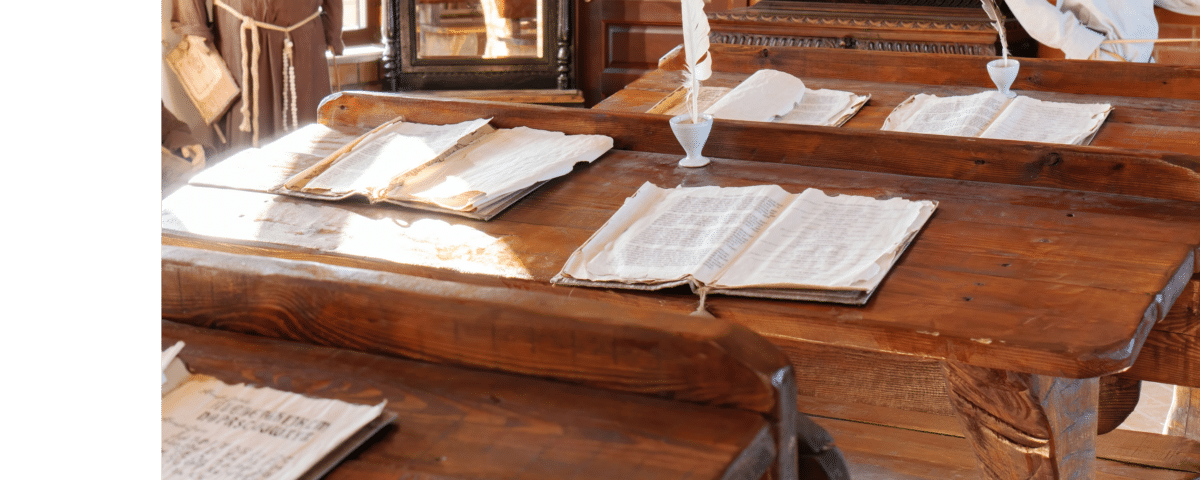
Dental History: Ancient Dentistry
June 15, 2024Dental history has a long and eclectic past that is rooted in the ancient worlds and has evolved to current practices through the contributions of modern thought and practices–much of which was pioneered through dentistry in the Age of Enlightenment. In our previous AlgerBlog, we looked at the dental history of the ancient world, highlighting evidence of prehistoric dentistry in ancient humans and our human-adjacent ancestors, the Neanderthals. We traced the evolution of ancient dentistry across the globe, identifying early knowledge, practices, and tools perpetuated in the ancient cultures of Egypt, Greece, China, and Rome. In doing so, we glimpsed how some of those ancient contributions gave way to modern dentistry, such as the Iron Age toothpaste of China and India, while other examples, such as the long-debunked belief in tooth worms, were ultimately dead ends.
In this blog article, we look at a significant turning point in dental history: the dental contributions made during the Age of Enlightenment, which helped reorient dental practices away from some of the superstitious foundations of earlier eras and toward a more modernizing dentistry based in science and logic.
Defining the “Age of Enlightenment”
The Age of Enlightenment was a philosophical movement of the 17th and 18th centuries that started in Europe (heavily based in France) and which significantly influenced intellectual thought and societal practices of the greater Western world. Foundational to the Enlightenment was a worldview based on rational thought–thus, this era is alternately known as the “Age of Reason.” While significantly influenced by the philosophers of ancient Greece, the Enlightenment marks a drastic shift towards modernization with knowledge attained through rational thought and observable sense experiences (i.e., “empiricism”). This emphasis on empiricism led Enlightenment thinkers to the scientific method, whereby scientific knowledge is based on objective observation and rational analysis of data and is subject to repeatable experimentation. It should come as no surprise that science in the Age of Enlightenment bore significant advancements, including in the field of dentistry. However, before we start listing the important advancements and defining figures of Enlightenment-era dentistry, we first need to acknowledge some key contributions of the Middle Ages, which helped lay the groundwork of the dental profession and codified key dental practices and knowledge in a few seminal writings.
Influential Dentistry of the Middle Ages
Laying the Groundwork for a Dental Profession
France spearheaded the formal structuring of a dentistry profession in the 13th century with the 1210 establishment of a Guild of Barbers. Historically speaking, barbers were responsible for administering much of the early dental practices of the Middle Ages across Europe. This formal guild categorized barbers into two groups: “surgeons,” who were formally educated and trained to carry out complex surgical procedures, and “lay barbers” (or barber-surgeons), who provided more routine hygienic services such as shaving, bloodletting, and tooth extraction. By 1400, France had implemented a series of royal decrees that altered this second group, prohibiting lay barbers from practicing surgical procedures with the exceptions of bleeding, cupping, leeching, and extracting teeth.

Seminal Dental Writings
The 16th century saw the publication of two texts considered to be seminal dental writings. The first is The Little Medicinal Book for All Kinds of Diseases and Infirmities of the Teeth by Artzney Buchlein. This writing was included as the 13th and final chapter of a more encompassing medical treatise, the Artzneybuch. Buchlein’s chapter is popularly held as the first section/booklet devoted entirely to dentistry. Its 13 sections cover a wide spectrum of established dental knowledge, including basic information about the normal number and growth process of teeth, common dental ailments (e.g., toothaches and decay), and specific dental techniques (e.g., tooth extractions and gold fillings).
Ambroise Paré, renowned as the “Father of Surgery,” published his Complete Works in France in 1575. Like Buchlein’s text, Paré’s Complete Works served as a practical read about surgery and covered a number of dental surgeries, including techniques for tooth extractions and jaw fractures.

Dentistry in the Age of Enlightenment
Overall, the 1600s were a period of transition and gradual improvement in dental care. While the practices and knowledge were basic compared to modern standards, the groundwork laid during this time contributed to the eventual development of dentistry as a specialized field of medicine. The 18th century, by comparison, marked a period of dramatic forward progression for the profession and practice of dentistry.
France
Unsurprisingly, France was one of the frontrunners of Enlightenment-era dental advancements. For instance, the first seminal text of modern dentistry is likely The Surgeon Dentist, A Treatise on Teeth (Le Chirurgien Dentiste, 1728) by French surgeon Pierre Fauchard. Fauchard is known as “the Father of Modern Dentistry” in large part due to the success of this book, which served as a comprehensive overview of practical dentistry, addressing basic oral anatomy and function, operative and restorative techniques, and denture construction. Additionally, Fauchard and his book helped elevate the practice of dentistry to a more refined medical profession with a thorough textbook and acceptance by the top physicians of the day.
One of those top physicians was the Paris-based dentist and surgeon Claude Mouton, a pioneer of prosthodontics and cosmetic dentistry. He is regarded for his development and use of gold crowns, which, like modern crowns, were retained via a post in the root canal. He also advocated for white enamel coatings of gold crowns for a more natural look. His 1746 book is a treatise on prosthetic dentistry, and his contributions paved the way for further advancements, including the invention of the porcelain tooth (1791) by Alexis Duchateau and Nicholas Dubois de Chemant.
USA
Dental Emigres
By the latter half of the 1700s, formal dentistry had landed Stateside with the arrival of the English surgeon John Baker in Boston in 1763. Prior to Baker’s arrival, the American colonies were serviced by barber-surgeons since at least the 1630s. Baker is believed to be the first medically-trained dentist to relocate to the New World. More, however, followed in his wake, including fellow Englishman Robert Wooffendale, who emigrated to New York City in 1766, and the Frenchman Jacques Gardette, who moved to Philadelphia in 1778.
The First Homegrown Dentists: Isaac & John Greenwood
Boston-born Isaac Greenwood began practicing dentistry in 1779 and is considered to be the first American-born dentist. He was also the father to another famous American dentist, John Greenwood. John Greenwood ultimately surpassed his father’s contributions to dental history as George Washington’s dentist. John Greenwood provided the first US president with his famed “wooden” dentures, which were actually made of natural teeth fit into a frame of ivory. In addition, John Greenwood left a legacy as an early advocate for preventative dental care, being one of the first dentists to recommend regular teeth brushing, as a pioneer of pediatric dentistry, and as the inventor of the first foot-powered dental drill, known as the “dental foot engine.”
A Few Final Advancements In Enlightenment-era Dentistry
Famed revolutionist Paul Revere began practicing dentistry around 1770. And, in 1776, he became an early practitioner of dental forensics when he posthumously verified the body of his friend, Dr. Joseph Warren, by the dental bridge that he had constructed for Warren.
One final significant Enlightenment-era dental contribution comes from notable surgeon dentist Josiah Flagg. Flagg started practicing dentistry around 1790 in Boston. Shortly after, he built what is considered to be the first American-made dental chair by adding to a common Windsor chair an adjustable headrest and a drawer for storing dental instruments.

Moving Dentistry into Modernity
As dentistry moved out of the Age of Enlightenment and into the 19th and 20th centuries, it carried with it the spark of modernity initiated by the Enlightenment’s rational worldview. Benefiting from advancements in science, medicine, technology, and engineering and bolstered by the forward momentum of the Industrial Age, dentistry evolved into the field we know today. This subject of modern dentistry will be the focus of our next blog. Please read on to continue down the path of dental history and see what other educational avenues are available on the AlgerBlog, including information on the AlgerLight with LED, a piece of modern dentistry in its own right.



